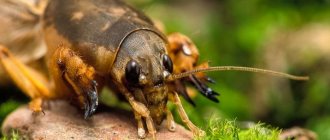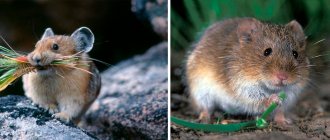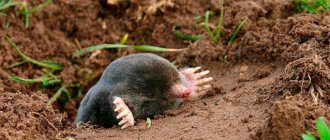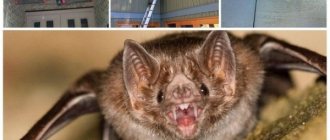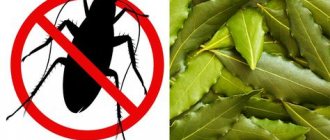What do hawk moths look like?
Hawk moth is a moth, that is, a night butterfly. Therefore, it has characteristic features:
- Large body.
- The wings are thin, with the lower ones being significantly shorter than the upper ones.
- The antennae are smooth, without thickening.
- The pattern on the body is similar to the texture of tree bark.
During the flight, the butterfly flaps its wings very quickly, resulting in the impression that it is a tiny bird. The length of the body reaches 11 centimeters, and the wingspan is 3-17 cm. The weight of the moth is 2-6 grams, while the female can weigh up to 8 grams.
Butterflies feed on nectar
The length of the antennae may vary. They have a rod-like structure, the apex can be pointed or slightly curved. The mouthparts are long, which allows them to collect nectar without sitting on the flower.
It can reach 25 centimeters in length. In some types the proboscis is underdeveloped. Others have additional palps on the lips. The insect's eyes have a complex structure, are round in shape, and covered with tufts. The eyes of the hawk moth are capable of distinguishing ultraviolet spectra.
The body of the butterfly is long, slightly narrowed towards the abdomen. As a rule, it is densely covered with hairs, which at the end form a “braid” or brush. The pectoral muscles are especially developed, which allows them to quickly flap their wings, developing enormous speed. Sometimes it reaches 54 km/h. while the wings rise up to 3120 times per minute.
Butterflies have ways of covering long distances by migrating between continents.
Hawk moths are able to perfectly combine protective and repellent colors. The upper wings are similar to the bark, so it is difficult to find insects on trees. The lower ones are very bright and catchy. Therefore, when danger appears, the butterfly throws out its lower wings, thereby scaring away the enemy.
Hawk Moth is good at camouflage
Hawkmoths have long legs, matching the color of their wings. There are a pair of spurs on the shins; similar spines are also found on the paws. The moth has a total of 6 legs.
Death's head hawk moth butterfly
The death's head hawk moth, which in some countries is called Adam's head, has been considered a harbinger of death for a long time among many peoples of Europe. The death's head hawk moth is distributed from southern Africa to the Shetland Islands, in the west it reaches the Azores Islands, in the east - Northern Iran.
Life cycle
The death's head butterfly mates in the spring. The female lays green, oval eggs on top of potato and other nightshade leaves. Caterpillars living in Europe are bright yellow or green with noticeable purple diagonal stripes on both sides of the body. The caterpillar's defenses include not only an amazing chirping sound, but also the release of a very toxic substance. The caterpillar has a sharp projection on its abdomen to scare away hungry birds.
Caterpillars are very voracious, so they soon reach a considerable length. Having reached the required size, the caterpillar burrows into the ground, where it forms a cocoon. The death's head pupa overwinters, and in the spring a butterfly emerges from it. Individuals heading south soon prepare for a long flight. Death's head hawk moth is a thermophilic species, therefore it prefers valleys at low altitudes above sea level and warm places in mountains of medium altitude.
Lifestyle
The Death's Head Hawkmoth leaves the African continent every year and flies north or east to reach Central Europe. These butterflies have narrow wings reinforced with thick veins, so they fly well.
Interestingly, both the butterfly, the caterpillar, and the pupa can make clearly audible sounds. During games, children often throw themselves at the death's head caterpillars, which at the same time emit a warning "howl" with their mouthparts. Even hawk moth pupae can creak. The squeak of adult butterflies can be clearly heard, with the help of which they try to repel any attack. The squeak is explained by the expulsion of air from the esophagus. This property and the image of the skull on the cephalothorax of the butterfly became the basis for the emergence of all kinds of prejudices.
What does it eat?
The caterpillars of the death's head butterfly, in addition to potato leaves, also eat the leaves of tomatoes, jasmine, snowberry, beets and cotton. Butterflies are active mainly at night. With their short but extremely strong proboscis, they pierce the skin of ripe fruits and drink their juice. They also feed on flower nectar and honeydew, but their favorite food is bee honey. The death's head butterfly often makes its way into hives, where it diligently examines the honeycombs and sucks honey from them.
Interestingly, bees do not usually attack butterflies. The attack occurs only in isolated cases, and as a result, the hawk moth dies. After a fatal dose of bee venom, a new stage of his mystical life begins. Having killed the death's head butterfly, the bees cover it with a layer of wax and leave it in this mummified form in the hive.
Death's Head Sightings
Death's-head Hawkmoth usually settles on plants that bloom at night, such as jasmine, tobacco, fuchsia, adonis and various types of orchids. These plants depend on moths for pollination because other types of insects cannot reach the pistil and stamens deeply hidden inside the flower. The death's head hawk moth caterpillar can be found in a potato field. Sometimes an adult butterfly appears at night near a light source. Large and strong, flying into a room, it can frighten a person with its size and swiftness alone, not to mention the fact that its wings emit a quiet hum. When potatoes were harvested by hand, pupae of this hawk moth were often found in the ground.
As a result of the use of pesticides in potato fields, a significant number of hawkmoth caterpillars are destroyed, and its pupae die from mechanized potato harvesting.
What types of hawk moths are there?
There is a huge variety of moths in this group. It will be very convenient to consider the hawk moth family in the table.
| Species names | Description of the wings |
| Hawk hawk | The upper ones are red in color with brown spots. There are bright blue “eyes” on the lower wings. |
| Hawkmoth is blind | On the lower tier there are bright spots imitating the eyes of animals. |
| Lesser oleander hawkmoth | It has green upper wings with a dark spot. The lower wings are bright orange with a pronounced border. |
| Brazhnik Tatarinov | The green upper wings are complemented by red-gray lower wings. |
| Euphorbia hawk moth | Green upper wings with a light stripe in the center and spots. The lower ones are black with a pink border. |
| Ademarius of Darius | The wings of the upper tier are discreet, helping to hide. The lower ones are pink with black trim. |
| Hawkmoth common tongue | Large wings are gray with stripes. Small ones are bright orange. |
| Lilac Hawkmoth | The upper ones are brown, and the lower ones are pinkish with clearly defined black transverse stripes. |
| Hawkmoth anthea | This butterfly has yellow wings with transparent “windows”. The body, or rather its sides, is also covered with yellow hairs. |
| Hawkmoth Megaera | Large wings are green, small wings are yellow. |
| Aspen Hawkmoth | Both large and small wings are lilac in color. |
| Pine Hawkmoth | Large wings are gray and inconspicuous. Small ones of the same color. At the same time, there are stripes on the body that form a clear square. |
| Pink Hawkmoth | The body and wings of the insect are yellow-pink, but the antennae are pure white. |
Strange "birds"
In the summer you can notice strange guests quickly flitting from one flower to another. They hover over marigolds and majors, for some reason remain indifferent to rose bushes, lower their tiny proboscis inside the flowers and fly away just as quickly.
The first thought most people have is, “Where are there hummingbirds in our area?” We are not in America, which means that the mysterious guests have nothing in common with the famous bird. Then who are these small, fast-scurrying creatures? Let me introduce you - this is an ordinary linguist. The photo of the insect below will give you the opportunity to carefully examine and evaluate its resemblance to a hummingbird. A butterfly hovers over a flower with its wings for a few seconds and drinks its nectar, almost the same way a bird does.
What do caterpillars look like?
The hawk moth caterpillar can be identified even without a photo. These are large, often very bright larvae. Covered with very little hair. The presence of a horn is characteristic, but not all species have it. The color can be pink, white, black, green. There may be oblique stripes and “eyes”.
The hawk moth has quite large caterpillars
There are also differences between each type of hawkmoth:
- The wine hawk moth caterpillar has a pair of large “eyes”; the larva is able to bend, lift the part of the body with the “eyes” and inflate it, which makes the spots even more frightening.
- The triangularis caterpillar is covered with yellow hairs. The larvae's legs have a pattern that makes them look like a reptile's eye.
- The larva of the poplar hawkmoth is green, with a yellow pattern and oblique stripes.
- The lilac in its larval stage is also bright green with pink stripes. In the absence of movement, it resembles a plant leaf, while the horn imitates the stem of the leaf.
- The Euphorbia Hawkmoth caterpillar has black rings on a yellow background. But the legs and head are bright red.
- The larva of the bedstraw hawkmoth is almost black, with yellow spots on the sides of the larva.
Caterpillar behavior
Hawkmoth caterpillars are large, thick and brightly colored. They have a horn-like outgrowth at the posterior end of their body. If you take such a caterpillar in your hands, it shrinks and begins to twitch violently. This is how she tries to scare away a possible predator. But humans should not be afraid of these caterpillars. The bedstraw hawk moth, which feeds on bedstraw, fireweed, and milkweed, is also not dangerous. The adult butterfly that this caterpillar will become will feed on nectar.
The hawkmoth caterpillar is “dressed very impressively”
Hawkmoths are considered nocturnal moths, but in fact many of them fly only during the day. These are primarily tongues and ishelweeds . Their names speak for themselves. The lingula has a very long proboscis (in fact, it plays the role of a tongue), and the ichelweeds are very similar to bumblebees; they are difficult to distinguish from a distance. Both feed on nectar, and during the day, when most flower heads are open, it is easier for them to find food. After all, these butterflies, unlike many others, must also feed at the imago stage - they do not have enough food accumulated in the “caterpillar” form
Tongue - a butterfly similar to a hummingbird
What are the nutritional features?
You can determine what hawk moths eat by simply observing them. Traditionally it is plant nectar. As a rule, insects have enough protein reserves accumulated in the larval stage.
Hawkmoths, based on their species, prefer certain plants, which is why they got their names.
The pine hawk moth prefers pine needles. Tobacco feeds on leaves, so it accumulates a large amount of nicotine, which makes the caterpillar poisonous. Convolvulus feeds on bindweed pollen. The death's head acts differently: it steals honey from the bees.
Hawk Moth Death's Head eats honey
And its secret is that the butterfly can make sounds similar to the queen bee. This hypnotizes the bees and allows the moth to feast on the honey in peace.
Features and habitat
In nature there is simply an incredible amount of the most diverse, beautiful and ugly, ordinary and supernatural. But, perhaps, the most popular of all this variety is the Hawk Moth butterfly.
Brazhnik wine medium
There are many legends about her. There is simply an incredible number of signs and superstitions associated with it. The butterfly Hawkmoth was given a not entirely secondary role in the popular film “The Silence of the Lambs,” in which the main character, suffering from manic tendencies, raised these moths and placed their pupae in the mouth of each of his victims.
In general, everything connected with the Hawk Moth butterfly has long been dark, mystical and frightening. For some reason, since ancient times, people have considered this moth a harbinger of disasters and always tried to destroy it when they met it.
Why did people dislike this beauty so much? There are several answers to this question. One of the very first and most compelling reasons for a person’s hatred of the Hawkmoth butterfly is its appearance.
Euphorbia Hawkmoth
The fact is that on her back it’s as if someone specially drew a human skull with crossbones. Looking at such a picture, it’s unlikely that positive thoughts will come to anyone’s mind.
The second reason for people’s dislike of this insect was its unpleasant squeak. It is so loud and unpleasant, like screaming, that it makes people shudder.
A picture on the back is added to this cry and the harbinger of trouble is ready. Such external data prompted many people to create creative works in which this sweet and wonderful creature mainly acted as a monster.
At its core, this butterfly is considered one of the largest. The span of her beautiful wings sometimes reaches up to 14 cm. This beauty belongs to the order Lepidoptera. The body of the butterfly has the shape of a cone, its wings are narrow and elongated.
Hawkmoth cingulata
The butterfly has long antennae, round eyes and a long proboscis, which is its main assistant in obtaining food. Short and strong spines are observed on the insect's legs. Scales are visible on the abdomen. The front wings are wide and somewhat pointed towards the apex.
The rear ones are slightly smaller, sloping towards the rear. Butterfly caterpillars are large in size and have five pairs of legs. Their color is difficult to confuse with anyone else. It is bright, with diagonal stripes and spots reminiscent of eyes.
At the end of the body of the Hawkmoth butterfly caterpillar, an outgrowth of a dense structure in the form of a horn is clearly visible. In many places, these caterpillars cause harm to forestry, gardening and agriculture, damaging crops.
Death's Head Hawkmoth (Acherontia atropos)
All species of this family are comfortable in a warm environment. But among them there are also those who, for some reason, can migrate much further north from their usual habitats.
They can easily fly across seas and mountain ranges. If we consider some types of Hawk Moths
, you can discern significant differences between them.
The oleander hawk moth,
for example, is a deep green color, like grass.
Its front wings have a distinctive pattern with varying shades of white, brown, green and purple. On the hind wings, gray and purple tones predominate, bordered by a green rim.
In the color of the ocellated hawkmoth
The predominant color is brown and a pattern reminiscent of marble. A longitudinal brown stripe is clearly visible along the front back of the insect. The base of the hind wings is soft pink with red tones. In the middle, large spots of black and blue, reminiscent of eyes, stand out clearly on them.
Tobacco Hawkmoth
gray with a slightly yellow color.
On the back of his body there are beautiful yellow rectangles separated by black stripes. This moth is very beautiful in real life. The linden hawk moth's
color is dominated by olive-green tones. Irregular dark spots are visible on its wings.
Where does the hawk moth live?
First of all, let us highlight the fact that they are very heat-loving. For this reason, they are especially abundant in tropical countries. In the middle zone, moths are less common. About 50 species can be found in Russia. They all love vegetation and live in forests. But there are exceptions: the turanga hawk moth loves the deserts of Central Asia.
Butterflies are awake at night. During the day, they all hide in the thick bark of trees. But the lilac hawk moth can feed around the clock. Before flying, butterflies have to flap their wings for a long time to warm their bodies. This is due to the fact that moths are cold-blooded.
In warm regions, butterflies are found all year round. When it is cold in the middle zone, they hide in a pupa, which is preserved in the soil or in moss.
When it gets cold, the madder tongue migrates to warm countries from Northern Europe.
It is worth noting that sometimes the migration of butterflies is caused not by a decrease in temperature, but by overpopulation of the area.
Some species of this butterfly live in the desert
Description of the species
Wine hawk moth belongs to the genus Deilephila. These are large and medium-sized butterflies with a wingspan of 40-80 mm. Representatives of the species are divided into three groups based on size.
Deilephilaporcellus
Lesser wine hawk moth is widespread in the Palearctic. The wingspan of the moth is 40-55 mm. The body is pink, the front wings are yellow-olive with wide pink margins along the edge. The hind wings are pink with an ocher band. Flies in May-August. The larva is dark brown with black shading; there is no horn. Often found in southern Russia, does not migrate.
Interesting fact. As a defense mechanism, caterpillars can relax their muscles to simulate death.
Deilephilaelpenor
Medium Wine Hawkmoth is an olive butterfly with a pink pattern. The base of the hind wings is black. Wingspan 50-70 mm. The head, chest and abdomen of the moth are olive green. The pinkish stripes on the back in the abdominal area merge into one longitudinal line. The antennae are thickened, grayish-pink. The eyes are large, complex, covered with scales. Insects have excellent vision; they see objects in low light.
Information. Hawkmoths fly at speeds of up to 50 km/h. The wind interferes with their flight and while feeding on flowers. When the wind force is 3 m/s, insects do not fly out to feed.
Insects are common in Europe, including the south of the Urals. Found in Turkey, Iran, Central Asia, India, Korea, Japan and China. It lives in gardens, at the edge of the forest, and on roadsides. Settles on honeysuckle bushes, petunias and iris flowers. Moths living in gardens and parks pollinate 5-10% of nearby trees and shrubs.
Attention. Medium wine hawk moth is listed in the Red Book of Karelia and the Belgorod Region as a rare species.
The wine hawk moth caterpillar can be green or dark brown, almost black in color. On the 4th-5th body segment there are round black eyes with a white border. The tail horn is short, black at the base, and the tip is white. Due to their large size (70-80 mm), the caterpillars make a terrifying impression on people. They are actually not dangerous. The larvae do not even cause serious harm to plants.
In case of danger, the wine hawk moth caterpillar is capable of inflating a segment of the body that has eyes. She draws her head in and assumes a sphinx pose, lifting her front legs off the surface. At the same time, she becomes like a snake. Given the impressive size of the body, enemies such as birds prefer not to engage in combat.
Hippotioncelerio
The largest representative of the species reaches sizes of 70-80 mm. The color of the elongated body and wings is olive-brown. A gray-blue longitudinal line is noticeable along the entire body from the head to the end of the abdomen. The wings have patterns of dark strokes and wide light stripes. Caterpillars grow up to 90 mm. The color is green or brown, there are light dots on the sides and a longitudinal white stripe. The horn is long, straight, and brown at the end. On the first segment of the chest there is a black eyespot, on the second - white. What does the wine hawk moth caterpillar eat? The tropical species is not original in its choice of diet; its larvae live on bedstraw, lilac, bindweed and other plants. The butterfly is common in warm countries - Africa, Central and South Asia. It migrates to the south of Europe in the summer season, flying vast distances, and does not winter. At home it produces up to five generations per year.
Hawk Moth Life Cycle
During reproduction, it goes through the following stages:
- 5-10 days in egg shape.
- 17-35 days in the larval stage.
- From 10 days to 3 years in the form of a pupa.
- 2-3 weeks in the adult stage.
Under good conditions, three generations appear per year. Butterflies find partners due to the ability of the latter to secrete pheromones. Females also change in appearance: their bodies thicken, and in flight they make characteristic sounds.
Mating occurs at positive temperatures. The ocellated hawk moth is the least demanding of it. Together with the seminal fluid, the female butterfly also receives protein for nutrition. Within a day she lays eggs. They can be located either singly or in groups. Laying continues for 2-3 days. For example, the average wine hawk moth lays up to 300 eggs, and the linden hawkmoth lays only 60-80.
After 5-10 days (depending on the type of moth), the incubation period ends. By this time the larvae change color. They also feed mainly at night. Over the entire period of the caterpillar's existence, it molts several times. After this, it pupates and lies in the soil. The depth of the hole also depends on the type of moth.
The pupa, like the caterpillar, has a characteristic horn, which distinguishes it from other types of butterflies.
The transformation of a pupa into a butterfly begins in the spring. The pupa can lie in the soil for several months or up to three years.
A caterpillar becomes a pupa before becoming a butterfly
Life expectancy depends on the type of hawk moth. On average the period is 2-3 weeks. Some species may enter hibernation or torpor until favorable times occur. If the butterfly does not feed, but lives off the substances accumulated in the pupal stage, it dies after it leaves offspring.
Habitat
An insect similar to a hummingbird is capable of flying over long distances. Over the course of one year, up to two generations of hawk moths manage to develop. The first flies from the first days of May to mid-July. For the most part it consists of individuals arriving from the south. The second generation flies from August to October. At the same time, some butterflies migrate to warm regions in the fall.
An insect similar to a hummingbird can be found in almost any country with a warm and temperate climate. For example, in Crimea, hawk moths are found everywhere and produce at least three generations during the year. Both the butterfly and the pupa overwinter. Moreover, if there is a prolonged thaw in winter, they can make an unscheduled flight, therefore, they can be seen in any winter month.
They prefer open, well-warmed areas as permanent habitats. In cities, it can be seen in flower beds, hovering over flowering plants. In wild conditions, the hawk moth prefers to feed on the nectar of cornflowers and blueberries, and in cultivated landscapes - geraniums and petunias.
The world of insects is vast and amazing. A special place in it is occupied by lepidoptera, or butterflies, the diversity of which amazes everyone: the layman, the amateur, and even the researcher. Thus, among the well-known marigolds and cabbages, there are truly exotic representatives of the class. The hawk moth butterfly is similar. The family has such unofficial names as “sphinx” or “northern hummingbird”. The origin of the first is associated with the unusual way the moth eats food, the second - with the heroic size of usually fragile and graceful insects.
Entomologists have identified a huge number of species of hawk moth butterflies, each of which has a distinctive color and a distinctive wing pattern. You can verify this by looking at specific examples. Thus, the wine hawk moth has exquisite burgundy wings; The death's head hawk moth stands out among others due to the unique pattern on its wings and back, reminiscent of a symbolic image of a human skull.
What is the reason for such a wide range of color varieties of species of one family? Scientists attribute this fact to the dependence of color changes on the animal’s diet and habitat. However, despite such a wide palette, most hawkmoth butterflies are decorated with a pattern, the compositional elements of which are an oblique stripe and large “eye” spots.
Enemies of butterflies
Protective coloration allows moths to hide from their enemies. These can be birds, frogs, lizards, turtles, mantises, spiders and bats. Some mammals also eat butterflies. Especially often, enemies destroy larvae, pupae and egg laying. To avoid extinction, butterflies leave a lot of offspring.
The most dangerous hunters for moths are night hunters: bats and fruit bats. Sometimes wasps parasitize the larvae. Fungi, bacteria, and viruses can also enter.
Some species of hawk moths have learned to emit ultrasound to scare away bats.
Are hawk moths useful?
Like any insect, it pollinates the plant. At the same time, they do not cross them, but collect nectar only from similar plants. The caterpillars feed on leaves, but they do not eat much and cannot cause any significant harm. But there are exceptions. The tobacco hawk moth is very voracious, as is its caterpillar.
When growing tobacco and tomatoes, chemicals are used to get rid of tobacco hawk moth caterpillars.
But not only in nature, butterflies can be beneficial. Due to their large size, the larvae are used in neurobiology. In addition, they can be easily bred to provide nutritious food for reptiles.
In this video you will see how the hawk moth feeds on pollen:
Is it possible to breed butterflies at home?
In order for the hawkmoth butterfly to live at home, you need to provide it with a temperature of + 22 degrees, and the duration of daylight is at least 14 hours. An insectarium is used for breeding. You need to spray the container regularly to increase humidity. The caterpillars should have a bowl or box; it is recommended to cover its walls with mesh so that the larvae can crawl along it. The container cannot be tightly closed; there must be ventilation.
During the pupal stage, it is necessary to ensure sufficient soil thickness. This could be peat or moss. The soil should always be moist, but not wet. You can feed with water with added honey. Plants are also used if caterpillars are present.
The container with water must be covered, otherwise the larvae may fall from it and drown.
It is especially beneficial to place flowering plants in a large container. Then the food will be natural. If you comply with the growing requirements, you can observe all stages of hawk moth development.

